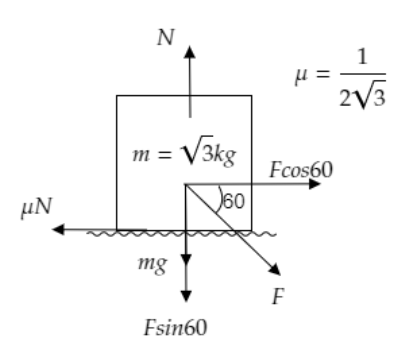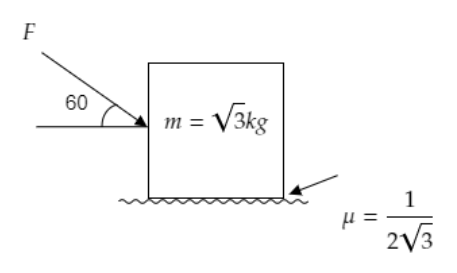
Answer
409.2k+ views
Hint: The block at rest experiences static friction and starts to move only when the applied force $F$ overcomes maximum static friction ${\left( {{f_s}} \right)_{\max }}$. Hence, the maximum value of force applied to not move the block must be equal to the maximum static friction for the block to remain stationary.
Complete step by step answer:
Step 1: Sketch the figure depicting the forces acting on the block with force $F$ resolved into its components. List the values of the known quantities.

Given, the mass of the block is $m = \sqrt 3 {\text{kg}}$ and the coefficient of static viscosity is $\mu = \dfrac{1}{{2\sqrt 3 }}$ . The force $F$ acting on the block is directed at an angle $\theta = 60^\circ $ .
Step 2:
Obtain an expression for the forces acting vertically on the block of mass $m$ .
In the figure, the vertical component of the force, $F\sin 60^\circ $ and the weight of the block, $mg$ are in the same direction. Also, $F\sin 60^\circ $ and $mg$ appear to be antiparallel to the normal force $N$ .
Thus we can express the total forces acting on the block in the vertical direction by, $N = F\sin 60^\circ + mg$ ------(1).
Step 3:
Obtain an expression for the forces acting horizontally on the block of mass $m$ .
In the figure, the horizontal component of the force $F$ acting on the body is $F\cos 60^\circ $ .
Since the block is at rest, static friction ${f_s}$ acts on the block and is in a direction opposite to the horizontal component of the force which tries to move the block.
The limiting value of static friction is given by, ${\left( {{f_s}} \right)_{\max }} = \mu N$ , where $\mu $ is the coefficient of static friction and $N$ is the normal force acting on the block. This maximum static friction ${\left( {{f_s}} \right)_{\max }}$ is antiparallel to the horizontal component $F\cos 60^\circ $ .
Thus we can express the total forces acting on the block in the horizontal direction by, $F\cos 60^\circ = \mu N$ ------(2).
Step 4:
Obtain an expression for $F$ using equations (1) and (2).
Equation (1) gives us $N = F\sin 60^\circ + mg$ .
Equation (2) gives us $F\cos 60^\circ = \mu N$ .
Substitute (1) in (2) to get, $F\cos 60^\circ = \mu \left( {F\sin 60^\circ + mg} \right)$ .
On simplifying the above equation we get, $F\cos 60^\circ - \mu F\sin 60^\circ = \mu mg$ .
Substituting $\cos 60^\circ = \dfrac{1}{2}$ and $\sin 60^\circ = \dfrac{{\sqrt 3 }}{2}$ in the above equation to get, $\dfrac{1}{2}F - \mu \dfrac{{\sqrt 3 }}{2}F = \mu mg$ . Simplifying the above equation gives us, $\dfrac{F}{2}\left( {1 - \sqrt 3 \mu } \right) = \mu mg$ .
This then becomes, $F = \dfrac{{2\mu mg}}{{\left( {1 - \sqrt 3 \mu } \right)}}$ -----(3).
Substitute the values $m = \sqrt 3 {\text{kg, }}\mu = \dfrac{1}{{2\sqrt 3 }}$ and $g = 10{\text{m/}}{{\text{s}}^2}$ in equation (3) to get, $F = \dfrac{{2 \times \dfrac{1}{{2\sqrt 3 }} \times \sqrt 3 \times 10}}{{1 - \left( {\sqrt 3 \times \dfrac{1}{{2\sqrt 3 }}} \right)}} = 20{\text{N}}$ .
Therefore, the maximum force exerted on the given block so that it does not move is $F = 20{\text{N}}$ .
Hence, the correct answer is option (A).
Note: When a vector is resolved into its horizontal and vertical components the original vector makes an angle $\theta $ with its x component (horizontal component). Hence, the horizontal component of the vector is expressed in terms of $\cos \theta $ and the vertical component is expressed in terms of$\sin \theta $ as the vector along with its components constitutes a right triangle.
Complete step by step answer:
Step 1: Sketch the figure depicting the forces acting on the block with force $F$ resolved into its components. List the values of the known quantities.

Given, the mass of the block is $m = \sqrt 3 {\text{kg}}$ and the coefficient of static viscosity is $\mu = \dfrac{1}{{2\sqrt 3 }}$ . The force $F$ acting on the block is directed at an angle $\theta = 60^\circ $ .
Step 2:
Obtain an expression for the forces acting vertically on the block of mass $m$ .
In the figure, the vertical component of the force, $F\sin 60^\circ $ and the weight of the block, $mg$ are in the same direction. Also, $F\sin 60^\circ $ and $mg$ appear to be antiparallel to the normal force $N$ .
Thus we can express the total forces acting on the block in the vertical direction by, $N = F\sin 60^\circ + mg$ ------(1).
Step 3:
Obtain an expression for the forces acting horizontally on the block of mass $m$ .
In the figure, the horizontal component of the force $F$ acting on the body is $F\cos 60^\circ $ .
Since the block is at rest, static friction ${f_s}$ acts on the block and is in a direction opposite to the horizontal component of the force which tries to move the block.
The limiting value of static friction is given by, ${\left( {{f_s}} \right)_{\max }} = \mu N$ , where $\mu $ is the coefficient of static friction and $N$ is the normal force acting on the block. This maximum static friction ${\left( {{f_s}} \right)_{\max }}$ is antiparallel to the horizontal component $F\cos 60^\circ $ .
Thus we can express the total forces acting on the block in the horizontal direction by, $F\cos 60^\circ = \mu N$ ------(2).
Step 4:
Obtain an expression for $F$ using equations (1) and (2).
Equation (1) gives us $N = F\sin 60^\circ + mg$ .
Equation (2) gives us $F\cos 60^\circ = \mu N$ .
Substitute (1) in (2) to get, $F\cos 60^\circ = \mu \left( {F\sin 60^\circ + mg} \right)$ .
On simplifying the above equation we get, $F\cos 60^\circ - \mu F\sin 60^\circ = \mu mg$ .
Substituting $\cos 60^\circ = \dfrac{1}{2}$ and $\sin 60^\circ = \dfrac{{\sqrt 3 }}{2}$ in the above equation to get, $\dfrac{1}{2}F - \mu \dfrac{{\sqrt 3 }}{2}F = \mu mg$ . Simplifying the above equation gives us, $\dfrac{F}{2}\left( {1 - \sqrt 3 \mu } \right) = \mu mg$ .
This then becomes, $F = \dfrac{{2\mu mg}}{{\left( {1 - \sqrt 3 \mu } \right)}}$ -----(3).
Substitute the values $m = \sqrt 3 {\text{kg, }}\mu = \dfrac{1}{{2\sqrt 3 }}$ and $g = 10{\text{m/}}{{\text{s}}^2}$ in equation (3) to get, $F = \dfrac{{2 \times \dfrac{1}{{2\sqrt 3 }} \times \sqrt 3 \times 10}}{{1 - \left( {\sqrt 3 \times \dfrac{1}{{2\sqrt 3 }}} \right)}} = 20{\text{N}}$ .
Therefore, the maximum force exerted on the given block so that it does not move is $F = 20{\text{N}}$ .
Hence, the correct answer is option (A).
Note: When a vector is resolved into its horizontal and vertical components the original vector makes an angle $\theta $ with its x component (horizontal component). Hence, the horizontal component of the vector is expressed in terms of $\cos \theta $ and the vertical component is expressed in terms of$\sin \theta $ as the vector along with its components constitutes a right triangle.
Recently Updated Pages
How many sigma and pi bonds are present in HCequiv class 11 chemistry CBSE

Mark and label the given geoinformation on the outline class 11 social science CBSE

When people say No pun intended what does that mea class 8 english CBSE

Name the states which share their boundary with Indias class 9 social science CBSE

Give an account of the Northern Plains of India class 9 social science CBSE

Change the following sentences into negative and interrogative class 10 english CBSE

Trending doubts
Difference Between Plant Cell and Animal Cell

Difference between Prokaryotic cell and Eukaryotic class 11 biology CBSE

Fill the blanks with the suitable prepositions 1 The class 9 english CBSE

Differentiate between homogeneous and heterogeneous class 12 chemistry CBSE

Which are the Top 10 Largest Countries of the World?

One cusec is equal to how many liters class 8 maths CBSE

Give 10 examples for herbs , shrubs , climbers , creepers

The mountain range which stretches from Gujarat in class 10 social science CBSE

The Equation xxx + 2 is Satisfied when x is Equal to Class 10 Maths




